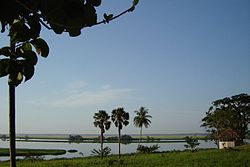Mai-Ndombe Province du Mai-Ndombe (French) | |
|---|---|
 | |
 | |
| Coordinates: 01°57′S18°16′E / 1.950°S 18.267°E | |
| Country | |
| Established | 2015 |
| Named after | Lake Maï Ndombe |
| Capital | Inongo |
| Government | |
| • Governor | Lebon Nkoso Kevani [1] |
| Area | |
• Total | 127,465 km2 (49,215 sq mi) |
| Population (2024 est.) | |
• Total | 2,291,000 |
| • Density | 17.97/km2 (46.55/sq mi) |
| Ethnic groups | |
| • Native | BaTeke, AnaMongo, Pygmies |
| Time zone | UTC+1 (WAT) |
| ISO 3166 code | CD-MN |
| License Plate Code | |
| Official language | French |
Mai-Ndombe is one of the 21 newest provinces of the Democratic Republic of the Congo created in the 2015 repartitioning when the former Bandundu province was split-up into the new provinces of Mai-Ndombe, Kwango, and Kwilu. [2] Mai-Ndombe was formed from the Plateaux and Mai-Ndombe districts, with the town of Inongo being elevated to the capital city of the new province.
Contents
The 2024 population was estimated to be 2,291,000. [3]

